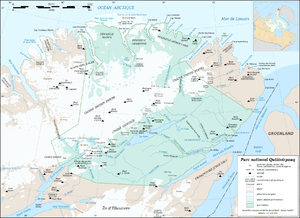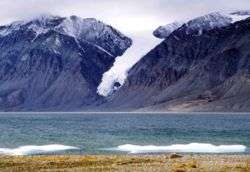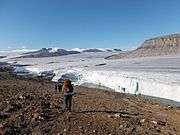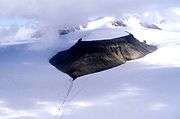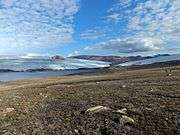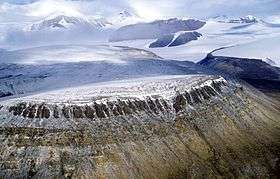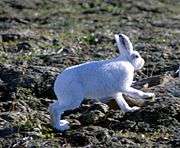Quttinirpaaq National Park is a Canadian national park. Located on the northeastern corner of Ellesmere Island in the Qikiqtaaluk Region of Nunavut, the most northerly extent of Canada, it is the second most northerly park on Earth after Northeast Greenland National Park. In Inuktitut, Quttinirpaaq means "top of the world". It was established as Ellesmere Island National Park Reserve in 1988, and the name was changed to Quttinirpaaq in 1999,[1] when Nunavut was created, and became a national park in 2000.[2]
The reserve covers 37,775 square kilometres (14,585 sq mi),[3] making it the second largest park in Canada, after Wood Buffalo National Park.
Landscape
The land is dominated by rock and ice. It is a polar desert with very little annual precipitation.
Much of the highlands of the park are covered in ice caps. These ice caps, and the glaciers that descend from them, date back at least to the last episode of glaciation.
The park includes Barbeau Peak, which at 2,616 m (8,583 ft) is the highest mountain in Nunavut.
Wildlife
Some wildlife, notably Arctic hares, lemmings, muskoxen and Arctic wolves reside in this national park, but sparse vegetation and low temperatures support only small populations. There is a very small Peary caribou population as well. Other animal inhabitants include ringed seals, bearded seals, walruses, polar bears, and narwhals. During summer months, birds nest in the park including semipalmated plovers, red knots, gyrfalcons and long-tailed jaegers. Common plants include dwarf willow and Arctic cotton, in addition to grasses and lichens. Plant and animal life is more concentrated in the Lake Hazen region, which has a milder climate than the surrounding ice cap-covered mountains and valleys.
Human history
Due to its high latitude and limited wildlife, there has never been any significant human presence within this part of Ellesmere Island. The pass from Tanquary Fiord through to Lake Hazen shows evidence of being used by Arctic people since about 5000 years ago. Tent rings and food caches show that the area was visited by pre-Dorset, Dorset and Thule people, the ancestors of modern Inuit.
The east and north end of the island was used as a starting point for various polar explorations. Fort Conger was an early Arctic exploration research base, and is now maintained as a Federal Heritage Building.[4]
Park
Parks Canada maintains warden stations and gravel air strips at Tanquary Fiord Airport, Lake Hazen and Ward Island. Tanquary Fiord and Lake Hazen are the main access points for tourists.[5] Beyond these warden stations, there are no facilities within the park itself. Two backpacking routes are the route between Lake Hazen and Tanquary Fiord, and a loop around the Ad Astra and Viking ice caps, both approximately 100 kilometres (62 mi).
In 2004, the park was one of nine sites added to Canada's tentative list of potential World Heritage Sites.[6]
Gallery
| Quttinirpaaq National Park |
|---|
| Map of Quttinirpaaq National Park |
| Tanquary Fiord, showing confluence of Air Force River, Rollrock River and Macdonald River |
| River Beauty and Ekblaw Lake |
| Confluence of Scylla and Charybdis Glaciers |
|
See also
References
- ↑ "Quttinirpaaq National Park". The Canadian Encyclopedia. Historica Canada. Retrieved 26 May 2015.
- ↑ Stewart, Emma J.; Howell, S. E. L.; Draper, D.; Yackel, J.; Tivy, A. (2008). Cruise tourism in a warming Arctic: Implications for northern National Parks (PDF). Contributed paper for the Canadian Parks for Tomorrow: 40th Anniversary Conference, May 8 to 11, 2008,. Calgary, Canada: University of Calgary. p. 1. Retrieved 28 May 2015.
- ↑ "Quttinirpaaq National Park of Canada". Parks Canada. 13 April 2015. Retrieved 28 May 2015.
- ↑ "Cultural Heritage". Quttinirpaaq National Park of Canada. Parks Canada. 18 September 2009. Retrieved 27 February 2010.
- ↑ "How to Get There". Quttinirpaaq National Park of Canada. Parks Canada. 20 December 2013. Retrieved 26 May 2015.
- ↑ "Quttinirpaaq". UNESCO - Tentative List. Retrieved 26 May 2015.
External links
|
|---|
|
| Ranges | |
|---|
|
| Mountains | |
|---|
|
| Passes | |
|---|
|
| Glaciers | |
|---|
|
| Regions | |
|---|
|
| Communities | |
|---|
|
| Parks | |
|---|
|
|---|
|
| National Parks | |
|---|
|
| National Park Reserves | |
|---|
|
| Marine Conservation Areas | |
|---|
|
| National Marine Conservation Area Reserves | |
|---|
|
| National Landmarks | |
|---|
|
| National Urban Parks | |
|---|
|
-
 Category:National Parks of Canada Category:National Parks of Canada
-
 Portal:Geography of Canada Portal:Geography of Canada
-
 WikiProject:Geography WikiProject:Geography
|

